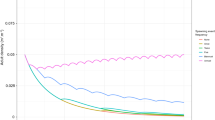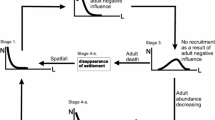Abstract
Three models are combined to investigate the effects of changes in environmental conditions on the population structure of the Eastern oyster,Crassostrea virginica. The first model, a time-dependent model of the oyster population as described in Powell et al. (1992, 1994, 1995a,b, 1996, 1997) and Hofmann et al. (1992, 1994, 1995), tracks the distribution, development, spawning, and mortality of sessile oyster populations. The second model, a time-dependent larval growth model as described in Dekshenieks et al. (1993), simulates larval growth and mortality. The final model, a finite element hydrodynamic model, simulates the circulation in Galveston Bay, Texas. The coupled post-settlement-larval model (the oyster model) runs within the finite element grid at locations that include known oyster reef habitats. The oyster model was first forced with 5 yr of mean environmental conditions to provide a reference simulation for Galveston Bay. Additional simulations considered the effects of long-term increases and decreases in freshwater inflow and temperature, as well as decreases in food concentration and total seston on Galveston Bay oyster populations. In general, the simulations show that salinity is the primary environmental factor controling the spatial extent of oyster distribution within the estuary. Results also indicate a need to consider all environmental factors when attempting to predict the response of oyster populations; it is the superposition of a combination of these factors that determines the state of the population. The results from this study allow predictions to be made concerning the effects of environmental change on the status of oyster populations, both within Galveston Bay and within other estuarine systems supporting oyster populations.
Similar content being viewed by others
Literature Cited
Abbe, G. R. 1988. Population structure of the American oyster,Crassostrea virginica on an oyster bar in central Chesapeake Bay: Changes associated with shell planting and increased recruitment.Journal of Shellfish Research 7:33–40.
Arakawa, K. Y. 1990. Competitors and fouling organisms in the hanging culture of the pacific oyster,Crassostrea gigas (Thunberg).Marine Behavioral Physiology 17:67–94.
Burreson, E. M. andL. M. Ragone-Calvo. 1996. Epizootiology ofPerkinsus marinus disease of oysters in Chesapeake Bay, with emphasis on data since 1985.Journal of Shellfish Research 15: 17–34.
Cook, T., M. Folli, J. Klinck, S. Ford, andJ. Miller. 1998. The relationship between increasing sea surface temperature and the northward spread ofPerkinsus marinus (Dermo) disease epizootics in oysters.Estuarine, Coastal and Shelf Science 40:587–597.
Dekshenieks, M. M. 1996. The effects of environmental variability on the population structure of the Eastern oyster (Crassostrea virginica): A modeling study. Ph. D. Dissertation, Old Dominion University. Norfolk, Virginia.
Dekshenieks, M. M., E. E. Hofmann, andE. N. Powell. 1993. Environmental effects on the growth and development of Eastern oyster,Crassostrea virginica (Gmelin, 1791), larvae: A modeling study.Journal of Shellfish Research 12:241–254.
Ford, S. E. 1996. Range extension by the oyster parasitePerkinsus marinus into the northeastern United States: Response to climate change?Journal of Shellfish Research 15:45–56.
galtsoff, P. S. 1931. Survey of Oyster Bottoms in Texas. U.S. Bureau of Fisheries Investigations Report 6. Washington, D.C.
Galtsoff, P. S. 1964. The American Oyster (Gmelin).Fisheries Bulletin 64:1–480.
Harvell, D. C., K. Kim, J. M. Burkholder, R. R. Colwell, P. R. Epstein, J. Grimes, E. E. Hofmann, E. Lipp, A. D. M. E. Osterhaus, R. Overstreet, J. W. Porter, G. W. Smith, andG. Vasta. 1999. Emerging marine diseases-Climate links and anthropogenic factors.Science 285:1505–1510.
Hofmann, E. E., E. N. Powell, J. M. Klinck, S. Boyles, andM. S. Ellis. 1994. Modeling oyster populations II. Adult size and reproductive effort.Journal of Shellfish Research 13:165–182.
Hofmann, E. E., E. N. Powell, J. M. Klinck, andG. Saunders. 1995. Modeling diseased oyster populations I. ModelingPerkinsus marinus infections in oysters.Journal of Shellfish Research 14:121–151.
Hofmann, E. E., E. N. Powell, J. M. Klinck, andE. A. Wilson. 1992. Modeling oyster populations III. Critical feeding periods, growth and reproduction.Journal of Shellfish Research 11: 399–416.
Hofstetter, R. P. 1977. Trends in Population Levels of the American OysterCrassostrea virginica Gmelin on Public Reefs in galveston Bay, Texas. Technical Series Number 24, Texas Parks and Wildlife Department, Austin, Texas.
Hofstetter, R. P. 1983. Oyster Population Trends in Galveston Bay 1973–1978. Management Data Series Number 51. Texas Parks and Wildlife Department, Coastal Fisheries Branch, Austin, Texas.
Hofstetter, R. P. 1990. The Texas Oyster Fishery. Report 40. Texas Parks and Wildlife Department, Austin, Texas.
Kim, Y. andE. N. Powell. 1998. Influence of climate change on interannual variation in population attributes of Gulf of Mexico oysters.Journal of Shellfish Research 17:265–274.
King, I. P. 1985. Strategies for finite element modeling of three dimensional hydrodynamic systems.Advances in Water Resources 8:69–76.
Marble, D. F. 1967. Some Computer Programs for Geographic Research. Special Publication No. 1. Departyment of Geography, Northwestern University, Evanston, Illinois.
Miller, C. B. 1983. The zooplankton of estuaries, p. 103–149.In B. H. Ketchum (ed.), Estuaries and Enclosed Seas. Elsevier Scientific Publishers, New York.
Parker, R. H. 1955. Changes in the invertebrate fauna, apparently attributable to salinity changes, in the bays of central Texas.Journal of Palenontology 29:193–211.
Powell, E. N., E. E. Hofmann, J. M. Klinck, andS. M. Ray. 1992. Modeling oyster populations I. A commentary on filtration rate. Is faster always better?Journal of Shellfish Research 11: 387–398.
Powell, E. N., E. E. Hofmann, J. M. Klinck, andS. M. Ray. 1994. Modeling oyster populations IV: Rates of mortality, population crashes and management.Fisheries Bulletin 92:347–373.
Powell, E. N., E. E. Hofmann, J. M. Klinck, E. A. Wilson-Ormond, andM. S. Ellis. 1995a. Modeling oyster populations V. Declining phytoplankton stocks and the population dynamics of American oyster (Crassostrea virginica) populations.Fisheries Research 24:199–222.
Powell, E. N., J. M. Klinck, andE. E. Hofmann. 1996. Modeling diseased oyster populations II. Triggering mechanisms forPerkinsus marinus epizooticsJournal of Shellfish Research 15: 141–165.
Powell, E. N., J. M. Klinck, E. E. Hofmann, M. M. Dekshenieks, E. A. Wilson-Ormond, andM. S. Ellis. 1995b Galveston Bay Houston Ship Channel Project, Calculation of Project Impact, Oyster Population Dynamics Model. U.S. Army Corps of Engineers, Galveston District, Galveston, Texas.
Powell, E. N., J. M. Klinck, E. E. Hofmann, andS. Ford. 1997. Varying the timing of oyster transplant: Implications for management from simulation studies.Fisheries Oceanography 6:213–237.
Powell, E. N., J. Song, M. S. Ellis, andE. A. Wilson-Ormond. 1995c. The state and long-term trends of oyster reefs in Galveston Bay, Texas.Journal of Shellfish Research 14:439–457.
Shumway, S. E. andR. K. Koehn. 1982. Oxygen consumption in the American oysterCrassostrea virginica.Marine Ecology Progress Series 9:59–68.
Simons, J. D., T. M. Soniat, E. N. Powell, J. Song, M. S. Ellis, S. A. Boyles, E. A. Wilson andW. R. Callender. 1992. An improved method for mapping oyster bottom using a global poisitioning system and an acoustic profiler.Journal of Shellfish Research 11:431–436.
Stafford, J. 1913. The Canadian Oyster: Its Development., Environment and Culture. The Mortimer Co., Ottawa, Canada.
Soniat, T. M., E. N. Powell, E. E. Hofmann andJ. M. Klinck. 1998. Understanding the success and failure of oyster populations: The importance of sampled variables and sample timing.Journal of Shellfish Research 17:1149–1166.
Soniat, T. M., L. E. Smith, andM. S. Brody 1989. Mortality and condition of the American oyster in Galveston Bay, Texas.Contributions to Marine Science 31:77–94.
Ulanowicz, R. E., W. C. Caplins, andE. A. Dunnington 1980. The forecasting of oyster harvest in central Chesapeake Bay.Estuarine, Coastal and Shelf Science 11:101–106.
Ward, G. H. andN. E. Armstrong. 1992. Ambient Water and Sediment Quality of Galveston Bay: Present Status and Historical Trends. Report Volume 1. 22, Galveston Bay National Estuary Program. Webster, Texas.
Wilson-Ormond, E. A., E. N. Powell, andS. M. Ray. 1997. Short-term and small-scale variation in food availability to natural oyster populations: Food, flow and flux.Pubblicazioni della Stazione Zoologica di Napoli Marine Ecology 18:1–34.
Author information
Authors and Affiliations
Corresponding author
Rights and permissions
About this article
Cite this article
Dekshenieks, M.M., Hofmann, E.E., Klinck, J.M. et al. Quantifying the effects of environmental change on an oyster population: A modeling study. Estuaries 23, 593–610 (2000). https://doi.org/10.2307/1352887
Received:
Accepted:
Issue Date:
DOI: https://doi.org/10.2307/1352887




